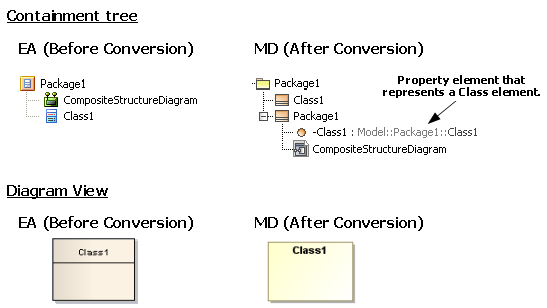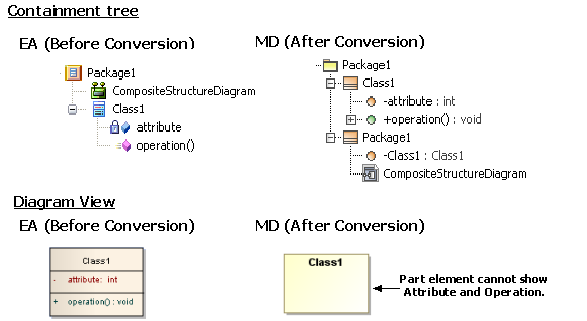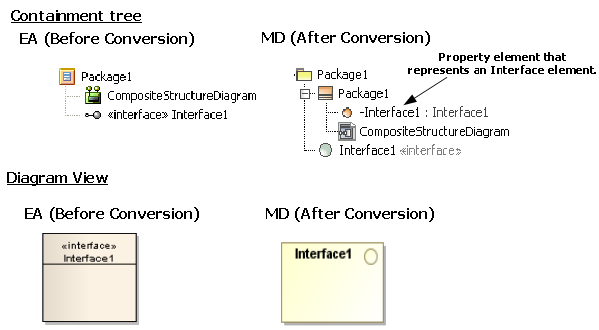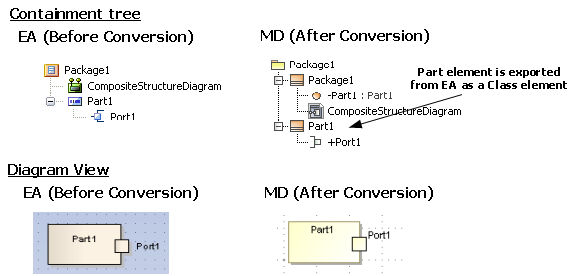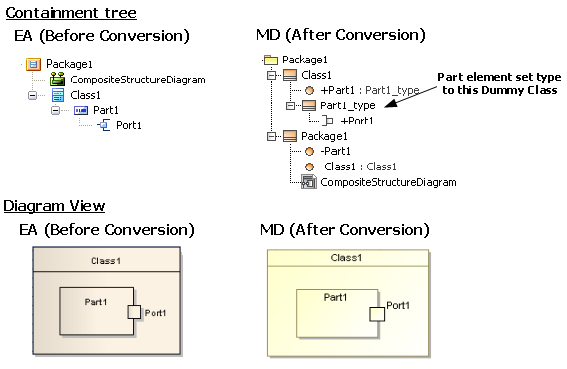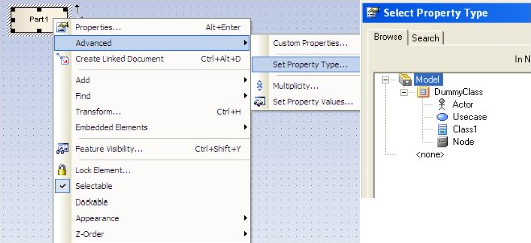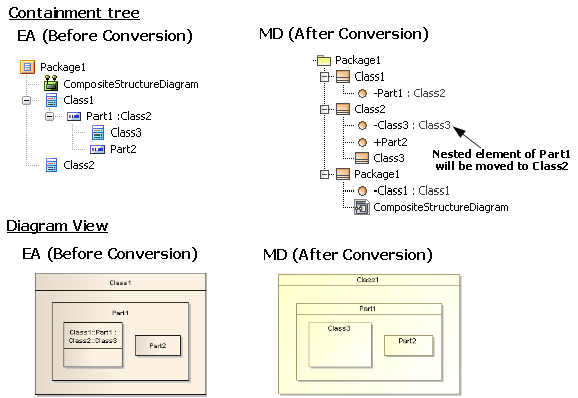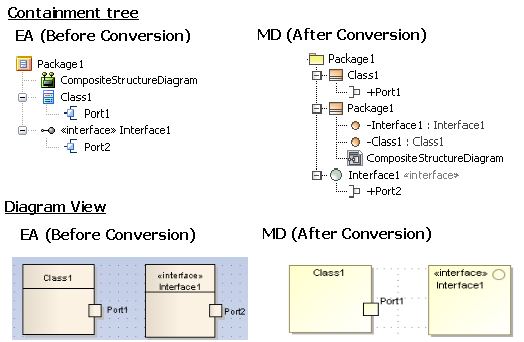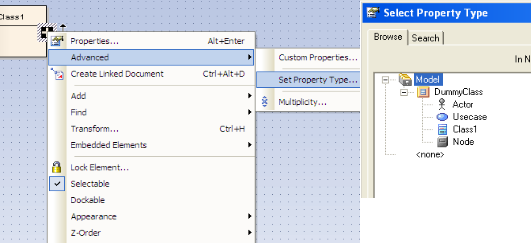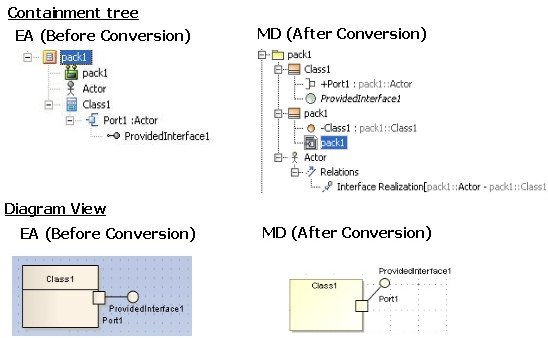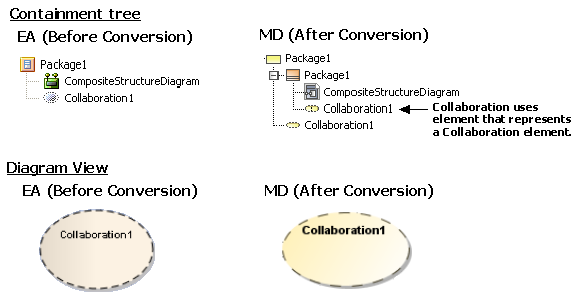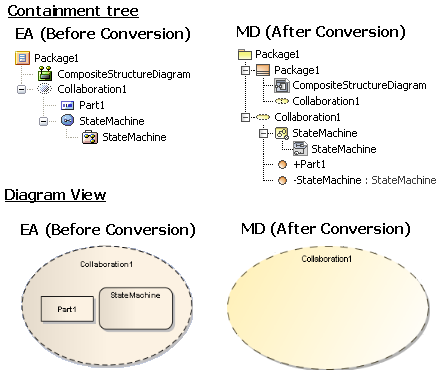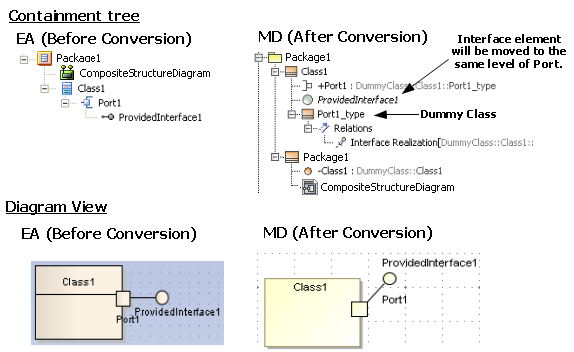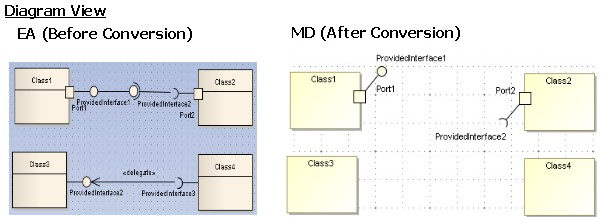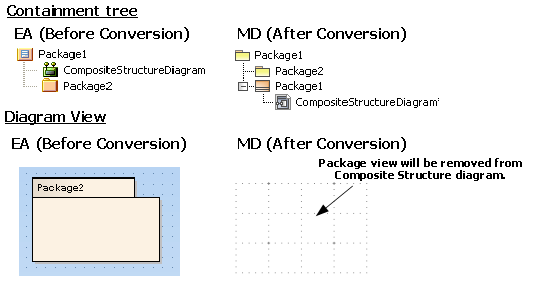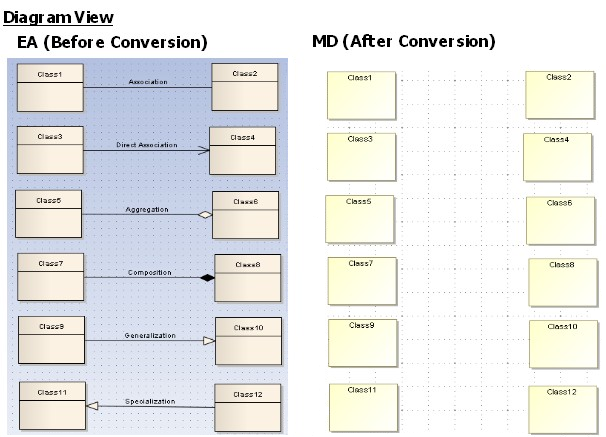On this page
This section presents additional EA specific Composite Structure diagram information.
Import elements
EA differs from MagicDraw, CEA, or CSM in the Composite Structure diagram's content elements design. The table below shows the differences by focusing on the EA’s elements and how they will be transformed or converted into a format MagicDraw, CEA, or CSM can correctly load and display. The element names shown in the table are the same in both EA and MagicDraw, CEA, or CSM GUI. The contents in the brackets ([…]) are the XMI element type references.
| Enterprise Architect | MagicDraw, CEA, CSM |
|---|---|
| Interaction | |
| Class [uml:Class] | Class [uml:Class] |
| Interface [uml:Interface] | Interface [uml:Interface] |
Part [uml:Class] Part [uml:Property] | Part [uml:Property] |
| Port [uml:Port] | Port [uml:Port] |
| Collaboration [uml:Collaboration] | Collaboration Use [uml:Collaboration] |
| Expose Interface [not exist] | |
| Connector [element type is not exist] | Connector [uml:Connector] |
| Assembly [element type is not exist] | |
| Delegate [element type is not exist] | Connector [uml:Connector] |
| Role Binding [uml:Dependency] | Role Binding [uml:Dependency] |
| Represents [uml:Dependency] | Dependency [uml:Dependency] |
| Occurrence [uml:Dependency] | Dependency [uml:Dependency] |
Conversion details
Dummy class
In MagicDraw, CEA, or CSM, the Composite Structure diagram needs a Context element to contain itself. However, in EA there is no Context element. After conversion, a dummy Class element will be created to represent the Context element of Composite Structure diagram.
A dummy Class will be named after the closest owner package of the Composite Structure diagram. The Composite Structure diagram and all of the Composite Structure elements will be placed inside the dummy Class element.
Dummy class.
Class
The Class element data will be normally copied even if the Class element is drawn in a Composite Structure diagram. A Property element will be created to represent the Class element. The Property element will be named after the Class element.
Property Representing a Class Element.
Class with Attributes and Operations
The Class view in EA will be converted to a Part in MagicDraw, CEA, or CSM. Attributes and Operations will not be shown in the Composite Structure diagram.
Part Element after Conversion.
Interface
The Interface element data will be normally copied even if the Interface element is drawn in a Composite Structure diagram. A Property element will be created to represent the Interface element. The Property element will be named after the Interface element.
Property Representing Interface Element.
Part
There are two types of Parts:
- Part with a port; and
- Part that sets a type to other elements.
Part with Port
If you assign the type of a Part element to a Class, Component, or Node, the Part element can have a Port . If a Part is not nested to any element, the Part element will be exported from EA as a Class. Therefore, this Part element can have a Port.
Part that does not Nest Element(s) with Ports.
If a Part is nested to an element and the type is not set, then the Part type will be used to set type to a dummy Class. This particular Part can have a Port. A dummy Class will be created at the same level of the Part element that sets type to it. The dummy Class will be named after the Part concatenating with _type.
Part that Nests Element(s) with Post.
Part that sets type to other elements
The type of a Part can be set to another element (such as a Class, Actor, Component, or Usecase) by right-clicking the Part element and selecting Advanced > Set Property Type > Select Property Type.
Setting Part Type.
If the Part type is set to a type that cannot be the owner of a port, the port will be removed.
In MagicDraw, CEA, or CSM, the Property element data cannot have any elements. However, in EA, it can have elements. Therefore, if you draw a Part element and it has an element inside it, that particular element will be relocated to an element, which is the Part type.
If a Part is not nested to any element, the Part element will be exported from EA as a Class. The element inside the Part will not be relocated. If that particular Part assigns a type to other elements, its type will always be set to Class.
Part that Sets Type to Other Elements.
If a Nested Part whose type is set to another element (such as a Class, Actor, or Usecase) and this Part contains Nested elements, all of the Nested elements of the Part will be relocated to the element that is the type of this Part.
Part that Sets Type to Other Elements has Nested Element Inside Itself.
Port
In MagicDraw, CEA, or CSM, a Property element that can have a Port is the Property that sets type to a Class, Component, or Node, and other elements cannot have a Port. However, in EA, most of the elements can have a Port.
If a Port is created with an element that is not a Class, Component or Node, the Port will be removed from the diagram view. However, its data will be preserved.
Only Class, Component, and Node Can Have a Port.
The following transformation message will open:
Removed view <xmi:id>: Invalid Port. Port can be added to Part that its type is set to Class, Component and Node only.
Port whose type is set to other elements
You can set the type of Port element to another element (a Class, Actor, Component, or Usecase) by right-clicking the Port element and selecting Advanced > Set Property Type > Select Property Type.
Setting Port Type.
Port whose type is set to another element and containing Expose Interfaces
If an Expose Interface is created on a Port and the Port type is set to another element, the Expose Interface data will be relocated to the Port's type element. For example, if the Port1 type is set to Actor, an Interface Realization (the Expose Interface data) will be placed inside the Actor after conversion.
Port that Sets Type to Other Element Contains Expose Interface.
Collaboration
The Collaboration element data and its nested data will normally be copied. However, if the Collaboration element is drawn in a Composite Structure diagram, a Collaboration use element will be created to represent the Collaboration element. The Collaboration use element will be named after the Collaboration element.
Collaboration use.
Collaboration containing other elements
A Collaboration can contain only Property, Activity, State Machine, and Interaction. Elements other than these will be removed. If any element is drawn inside the Collaboration, it will be removed from the diagram view.
Collaboration Containing Other Elements.
The following transformation messages will open:
Expose Interface
Expose Interfaces are the Provided and Required interfaces in MagicDraw, CEA, or CSM. You can draw a Provided Interface or Required Interface in a Port only and set the type of the Port to another element (an Actor, Use Case, or Class). You can create that particular Port on a Part element whose type is set to a Class, Component, or Node only.
Expose Interface with Port
If you draw an Expose Interface in a Port and the Port does not assign a type to any elements, that particular Port will be used to set type to a dummy Class. The dummy Class will be created and named after the Port concatenating with _type. The Interface element will be moved to the same level of the Port.
Expose Interface with Port.
If an Expose Interface is created on a Port and the type of the Port is set to another element, the Expose Interface data will be relocated to the Port's type element (see Port whose type is set to another element and containing Expose Interfaces for more information).
In MagicDraw, CEA, or CSM, some elements can be used as a Port type. These elements can have either a Provided Interface or Required Interface, or both.
The following is a list of the Port's type elements with specific conditions:
- Interfaces can only have a Provided Interface.
- Artifacts cannot have a Provided Interface.
- Information Items cannot have a Provided Interface.
- Signals cannot have a Provided Interface.
- Components always have both Provided and Required Interfaces.
- The other elements can have both Provided and Required Interfaces.
- After conversion, if the type of a Port is set to an Interface and the Port has an Expose Interface, only the Provided Interface will be shown and the Interface Realization data will be removed.
- Artifacts, Information Items, and Signals cannot hold Interface Realization. If the type of a Port is set to one of them, the Provided Interface will be removed. However, this does not affect the Required Interface.
- If the type of a Port is set to a Component and the Port has an Expose Interface, it will always show both the Provided and Required Interfaces.
Port’s Type Element with Specific Conditions.
The following transformation message will open:
Updated element <xmi:id>: Provided Interface conflicts with Port type. The Port type is updated to an owner of Interface Realization.
If an Expose Interface is created with an element that is not a Port, the element will be removed both from the Containment tree and diagram pane.
Expose Interface with Element that is not Port.
The following transformation message will open:
Removed element <xmi:id>: Invalid Element. Expose Interface can be added to Port only.
Expose Interface with relationship
In MagicDraw, CEA, or CSM, the Provided and Required Interfaces cannot be connected with any relationship. If there is any relationship connecting to the Expose Interface, it will be removed from both the Containment tree and diagram pane.
Expose Interface with Lines.
The following transformation message will open:
Removed element <xmi:id>: Invalid Element. Expose Interface cannot be connected with the element.
Package
In MagicDraw, CEA, or CSM, a Package cannot be drawn in a Composite Structure diagram. If it is drawn in EA, it will be removed from the diagram once it has been converted to MagicDraw, CEA, or CSM.
Package.
Assembly
In MagicDraw, CEA, or CSM, there is no Assembly line. It will be updated to a Connector.
The following transformation message will open:
Updated element <xmi:id>: Assembly updated to Connector.
Updating the Assembly Line to the Connector Line.
Dependency
There are many relationships that EA exporter exports to Dependency as the following elements:
- Delegate
- Role Binding
- Represents
- Occurrence
- Nest
- Derive
- Import
- Instantiate
- Usage
- Realize
- Trace
The above relationships will be shown in the diagram view as Dependencies with a stereotype.
Removed relationships
If an Association, Direct Association, Aggregation, Composition, Generalization, or Specialization is created in a Composite Structure diagram, it will be removed from the diagram view, but its data will be preserved.
Removing lines.
The following transformation messages will open:
Transformation report
A report containing the conflicts solved during transformation, along with other transformation information (such as special mapping and removal of some irrelevant data), is required to be provided to the users.
The following is a list of the transformation messages:
Related pages

